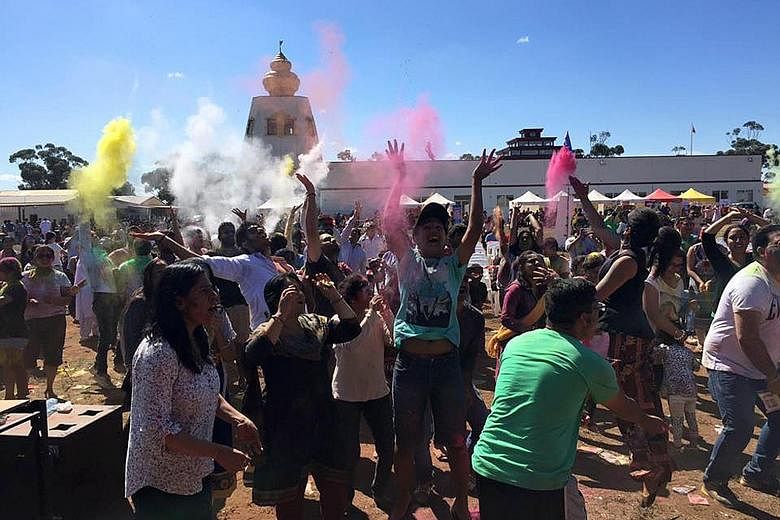On a quiet stretch of sprawling grassland in suburban Australia, crowds of Hindu worshippers gathered late last year to hold seven days of celebrations to mark the opening of a new multimillion-dollar temple.
Occupying 9ha on the outskirts of Melbourne, the Sri Durga Temple, complete with a five-tonne statue of the goddess Durga imported from India, can hold up to 5,000 people and is Australia's largest Hindu temple.
But the A$4.5 million (S$4.7 million) temple, funded almost entirely by community donations, is not just a religious monument - it is also a testament to the size and strength of Australia's fastest-growing migrant community.
Government figures show that Australia's 430,000-plus Indian population has more than trebled in just a decade. India was the largest source of migrants in the year up to the end of June, with 40,145 arrivals, up 18 per cent from 2014-15, according to the latest data released by the Department of Immigration and Border Protection.
It was followed by China, with 29,008 migrants, the United Kingdom (18,950) and the Philippines (11,917).
Indians now make up about 1.8 per cent of Australia's population of 24 million, the fourth-largest migrant group behind Britons at 5.1 per cent, New Zealanders at 2.6 per cent and Chinese at 2 per cent.
One of the noticeable features of the community is that they have been flocking to Australia's second-largest city, Melbourne, rather than Sydney, its largest.
Indians now make up about 3 per cent of Melbourne's population of 4.4 million.
Across the city, the Indian presence has become increasingly noticeable. Restaurants and spice shops have been popping up around the city and there are plans for the country's first retirement homes for Indians.
Last December, Victoria's state government named the south-east area of Dandenong - a hub of Indian clothing and food stores - the state's first official Little India precinct. The area was granted A$500,000, which is to be used for events, signage in the area and marketing.
"It will become a hub of activity - hosting events, a drawcard for tourism and boosting the local economy," said the Multicultural Affairs Minister, Mr Robin Scott.
The government plans to create a second Little India in Wyndham, a district in south-west Melbourne with a large Indian population.
Dr Sharad Gupta, the president of the Federation of Indian Associations of Victoria, an umbrella body for the state's communal organisations, said Indians have been attracted by the city's more affordable property prices and cost of living.
In addition, Melbourne has some of the country's leading universities, which have attracted large numbers of Indian students.
"Sydney is getting saturated and the cost of living is getting higher," Dr Gupta told The Straits Times.
"The western suburbs of Melbourne are still underdeveloped. There is a lot of land, decent houses, a better environment and quality of life and better job opportunities," he said.
But the city's Indian community was in the news following a series of ugly attacks on Indian students which attracted widespread media coverage in 2008 and 2009. Indian students held mass protests in the city and India's then prime minister raised concerns with his Australian counterpart.
But community leaders say efforts by the police, universities, the government and the local community have since helped to improve safety.
"Much credit goes to the police for controlling those types of crimes and places where people were travelling at night," Dr Gupta said. "There are a few incidents here and there but not like it was a few years back."
Across Australia, the Indian community is not only the nation's fastest growing but has been one of the most highly educated, with about 55 per cent holding university degrees, compared with a national average of about 19 per cent.
Overall, the influx, which has included large numbers of skilled migrants and foreign students, has been particularly trouble-free.
Analysts say this is due to the shared cultural background between Indians and Australians, including a deep passion for the sport of cricket.
But, as international relations expert Dr Pradeep Taneja noted, the shared ties extend much deeper.
"Indian migrants come from a country, like Australia, with a history of British rule," Dr Taneja, from the University of Melbourne, told The Straits Times.
"In Australia, they find a fairly similar political system and similar government institutions. It is much easier for them to understand how this country operates and for them to adjust and settle."
He added: "There is the cricket connection - many Indians are familiar with Australian cricketers' prowess - but it goes well beyond cricket."
Unlike in Sydney, which tends to have a few main hubs in which Indians are concentrated, Melbourne's Indian communities tend to be dispersed across the city.
In Sydney, three suburbs in the city's west have populations that are at least a quarter Indian. In contrast, Melbourne does not have such high concentrations but has numerous suburbs across the city, such as those in and around Dandenong, with Indian populations of more than 10 per cent.
"They (Melbourne's Indian migrants) have not formed ghettos and there is a lot of interaction between them and people of other different backgrounds," a researcher who has studied the community, Dr Philip Hughes, told The Straits Times. "Part of what reduces prejudices is people getting to know each other and having personal experience of each other."
Dr Gupta, a father of two who migrated from Delhi in 1996, said he believed most Indian migrants quickly adapted to cultural differences. "My son is 26 and is engaged to a Chinese girl," he said. "She does not speak Hindi, our mother tongue. My wife and I never objected. She is great - she's a lovely girl."
At the Sri Durga Temple, the temple's secretary, Mr Hari Julka, said the institution aimed to be a "centre of cultural variety".
"There is strong demand (for the temple) and it reflects the community's growth," he told The Straits Times.

